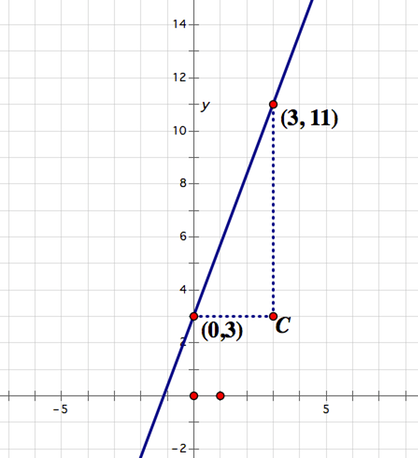Sometime back in the day, The Fresh Prince of Bel Air was still playing new episodes so we could watch Carlton do The Carlton Dance, not on YouTube, and you learned about slope.
You might remember slope as rise over run (ok), or the ratio of the change in y-coordinates to the change in x-coordinates between two points (better), or how steep a graph is. Someday, you'll expand that knowledge to graphs that aren't linear, but for now, we care about the slope of lines.
First things first: You don't need a formula to figure out slope. If I know two points on a line, let's say (0, 3) and (7, 11), I can graph those two points and make something called a slope triangle. Here's what a slope triangle looks like.

You might notice we drew a vertical segment from one point, and a horizontal segment from the second point, and made a right triangle. What we're going to do here is take a look at the lengths of the sides of this triangle. The horizontal leg (from (0,3) to (3,3)) has a length of 3. The vertical leg (from (3,3) to (3,11)) has a length of 8. If I think about slope as rise over run, I take the vertical length and divide it by the horizontal length, and get 8/3. Done.
If you're feeling a little excited, you might even remember a formula that helps you calculate slope without drawing any pictures. m = (y2 - y1)/(x2-x1).
In other words, subtract the y-coordinates; subtract the x-coordinates in the same order, then divide them.
Here's some more help, a video, and some examples:
Video: Calculating the Slope of a line between two points. (Patrick JMT)
Finding the slope between two points requires you to
find how much y-changes and divide it by how much x-changes. It is often thought of as ![]() . For example,
to find the slope between
. For example,
to find the slope between
(-4, 6) and (5, -10), we first determine that the y-value
changes by -16. We then see that the
x-value changes by +9, so our slope must be ![]() .
.
Rate of change is the same idea as slope, you may need to read some context to the problem, then explain what it means. For example…
A red sea urchin grows its entire life, which can last 200 years. If at age 30 the sea urchin has a diameter of 11.9 cm and at age 110 it has a diameter of 15.5 cm, what is the average growth rate of this urchin over the given period and what does this mean?
The diameter changes 3.6 cm and the number of years
is 80, so the slope is ![]() cm/yr or .045 cm/yr, which means that over the period
of 80 years the sea urchin averages .045 centimeters of growth every year.
cm/yr or .045 cm/yr, which means that over the period
of 80 years the sea urchin averages .045 centimeters of growth every year.